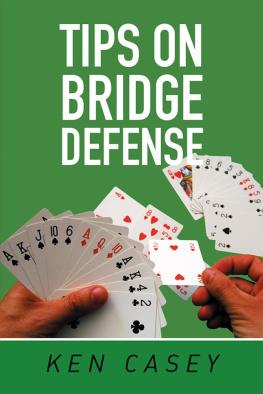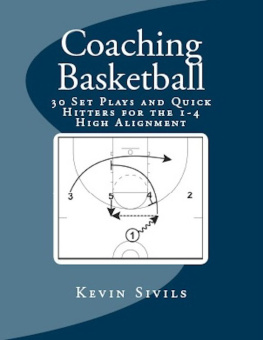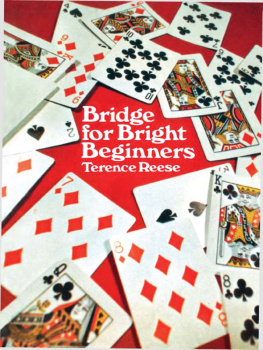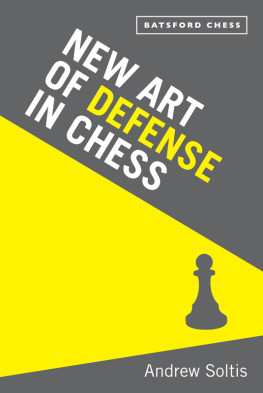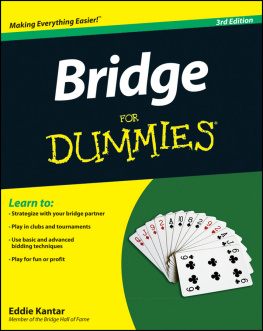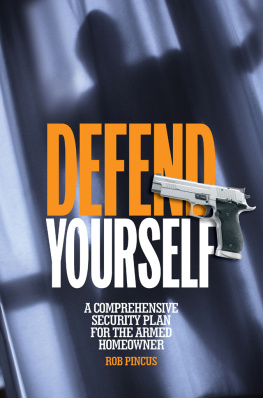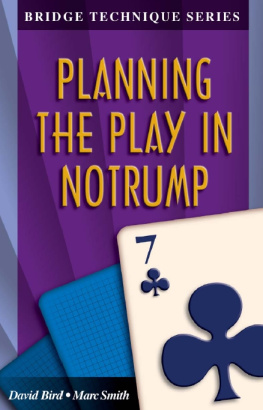Tips on
Bridge
Defense
KEN CASEY
Copyright 2016 by Ken Casey.
Library of Congress Control Number: 2016916226
ISBN: Hardcover 978-1-5245-4675-5
Softcover 978-1-5245-4674-8
eBook 978-1-5245-4673-1
All rights reserved. No part of this book may be reproduced or transmitted in any form or by any means, electronic or mechanical, including photocopying, recording, or by any information storage and retrieval system, without permission in writing from the copyright owner.
Any people depicted in stock imagery provided by Thinkstock are models, and such images are being used for illustrative purposes only.
Certain stock imagery Thinkstock.
Rev. date: 10/29/2016
Xlibris
1-888-795-4274
www.Xlibris.com
746994
Contents
If I have seen further, it is by standing on the shoulders of giants.
Issac Newton
Normally I try to avoid showering praise on a single individual since most projects are a group effort. Nevertheless, I will make an exception here. Frank Stewart, a world-renowned bridge columnist has done more than anyone I know to advance the science of bridge and to inspire others. A large part of my learning has come from Frank even though we have never met nor even know each other. My books are infused with his teachings. There is no one to whom I owe more. Thank you Frank; I can never repay you for all youve taught me. Frank is the champion of counting points and distributions. My two favorite books of his are called Who Has the Queen? and Play Bridge With Me. Other award winning books published by Frank are Winning Defense for the Advancing Bridge Player, Frank Stewarts Bridge Club and Franks World of Bridge.
Another bridge author who must also be placed on a pedestal is William Root. He anticipates your questions before the question even arises in your mind. His explanations are always succinct and to the point. In earlier days, bridge players wanting to learn how to play bridge would read Louis Watsons book, Watsons the Play of the Hand. Today that honor goes to William Root for his book, How to Play a Bridge Hand. He has also written two other fine award winning books: Modern Bridge Conventions, and How to Defend a Bridge Hand.
My third hero is David Bird. He is the king at giving tips. His 3 books, 52 Great Bridge Tips, Another 52 Great Bridge Tips, and 52 Great Bridge Tips on Declarer Play are 3 books that must be included in any experts bridge book collection. These 3 books alone would make David one of the greatest bridge authors. Then David published Winning Suit Contract Leads, and Winning Notrump Leads, two books which destroyed all previous thinking on leading. David would be my first to be included in any Bridge Hall of Fame for bridge authors. David has also written several other award winning books including Notrump Contracts, Miracles of Card Play, Win at Bridge in 30 Days, Secrets of Expert Card Play, Secrets of Expert Defense, and Defensive Signaling at Bridge.
It would not be fair to ignore the contribution of other excellent authors. The following books have all been award winning books on the topic of bridge play: Marty Bergens Declarer Play the Bergen Way; Eddie Kantars Take All Your Chances; Julian Ladermans A bridge to Inspired Declarer Play; Mike Lawrences How to Read Your Opponents Cards; and finally, but not least of all, and finally, but not least of all, Albert Dormers Dormer on Deduction.
A key part of being an expert is to tentatively determine Ss distribution. Initially assume that declarer has 5 cards in his bid suit. Then assume that declarer has a doubleton in the suit in which you and dummy are longest. Next assume that declarers other suits are split 3-3. If the bidding is instructive, modify this distribution accordingly. For example, if S opens 1 and later bids 2, assume that S is 5-4 in those two suits.
The 2 nd part of being an expert on defense is that you try to figure out what tricks you can possibly take. For example, if the contract is 4, you will need 4 tricks to set the contract. If dummy is strong and you can only image your team as taking 3 tricks, then look for ways to get a ruff. If you have a forcing defense, this will typically mean that you will continue to lead the suit even though declarer can ruff the 3 rd or 4 th trick. Its permissible to risk a ruff-sluff if you have a forcing defense. Sometimes you have to be aggressive, meaning that you may have to underlead an Ace. Most of the time it pays to be passive. If declarer will have to ruff, you should probably try to lead trumps to cut down on his ruffs.
The 3 rd part of being an expert is misleading the declarer. You should routinely play your cards out of the normal order. You should also hold up if this will create transportation problems for the declarer. When trumps are played, you should never take the first trump. Take the second to last of your trumps and then exhaust dummys last trump to convert the hand to notrump or lead your strong suit if you are in a forcing defense. When in doubt, try to remove entries to the dummy or strand the declarer back in dummy, hoping that declarer has trouble returning to his hand to take out your last trump.
When discarding, be cognizant that dummys long suit may set up if there are still entries available. Always keep parity; in other words, make sure you keep your suit the same length as dummys long suit. Watch partners discards and signals. Try to adopt Upside Down signaling so that declarer will not be alerted to your distribution. Also use Trump Suit Preference as modified, i.e. when S plays trumps, use your high trump to signal that you have an Ace or King in the minors. The most difficult action by a defender is leading away from a King or an Ace and yet that is often crucial to set the declarer. If you know your partner has an Ace or King in the minors, you can often figure out which minor the honor is in.
In leading, follow the rules in David Birds books on leading. I believe that one should adopt the BOSTON convention: Bottom of Something, Top of Nothing. This means that a low lead by partner always signifies that partner has the King or Queen or possibly a J10 or J9. If partner leads a small card in your bid suit, it means partner has 3 cards to the Q or K. If W leads an Ace, W has the King. If W leads an Ace followed by the Queen, W also has the King. If E plays the King and then the Ace, i.e. playing the cards out of order, E has a doubleton. If partner plays a card in declarers strong suit, it means partner has a singleton unless partner is trying to kill the dummy before trumps have been played.
EX. 1: With A as only entry to long suit, sacrifice K

Here the contract is 6 and W leads the 3, which is taken by dummys Ace. S next takes out trumps ending in his hand. S then leads the J, which is taken by Es K. E should then lead his K in order to kill dummys entry. At this point, Ss Q is blocking his ability to run dummys diamonds. E in fact led a club allowing S to unblock his Q and get to dummy with the Ace to make the contract.
EX. 2: Kill Ace entry by sacrificing K

Here the contract is 3NT and W leads the 2. When dummy takes his Q, E knows that S probably has the Ace (since W would have lead the Ace with the K). Therefore, defenders have only 2 heart tricks and 2 diamond tricks. When S leads a low diamond to dummys 10, E must win with his J and lead his K. If dummy wins and leads another diamond, E must let it ride and then take the 3 rd diamond lead with his Ace, thereby killing the board.
Next page
